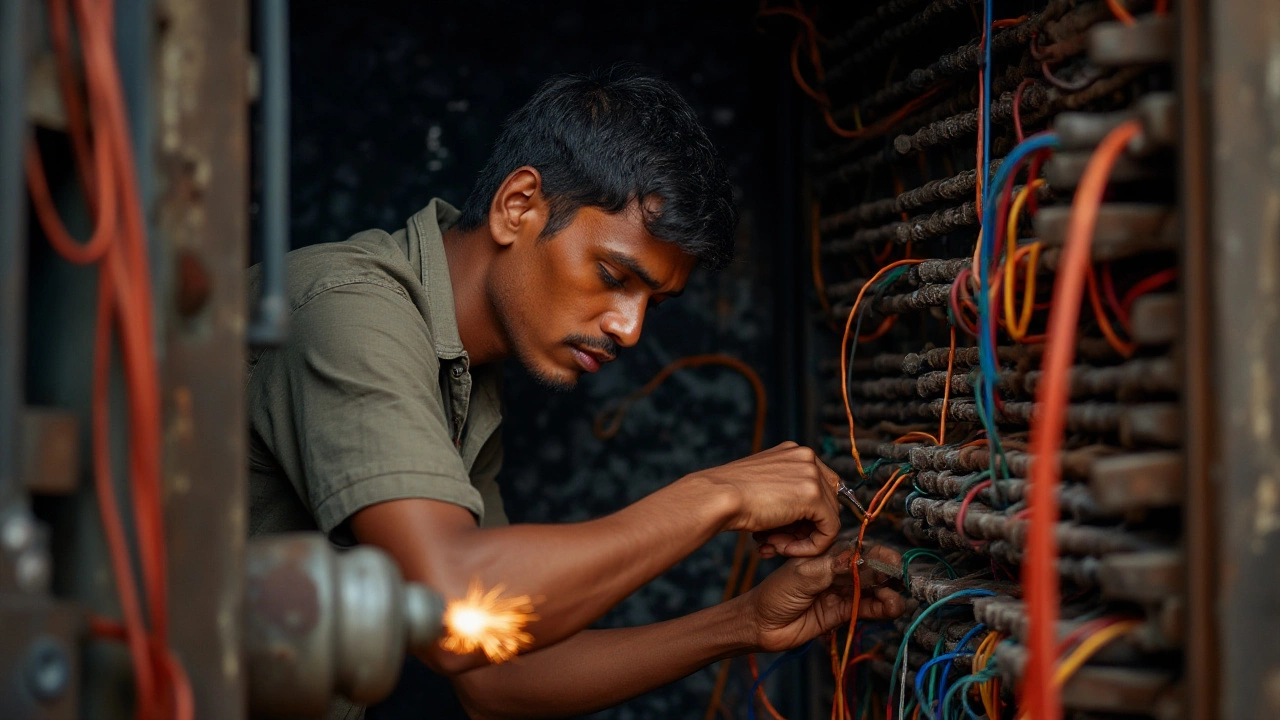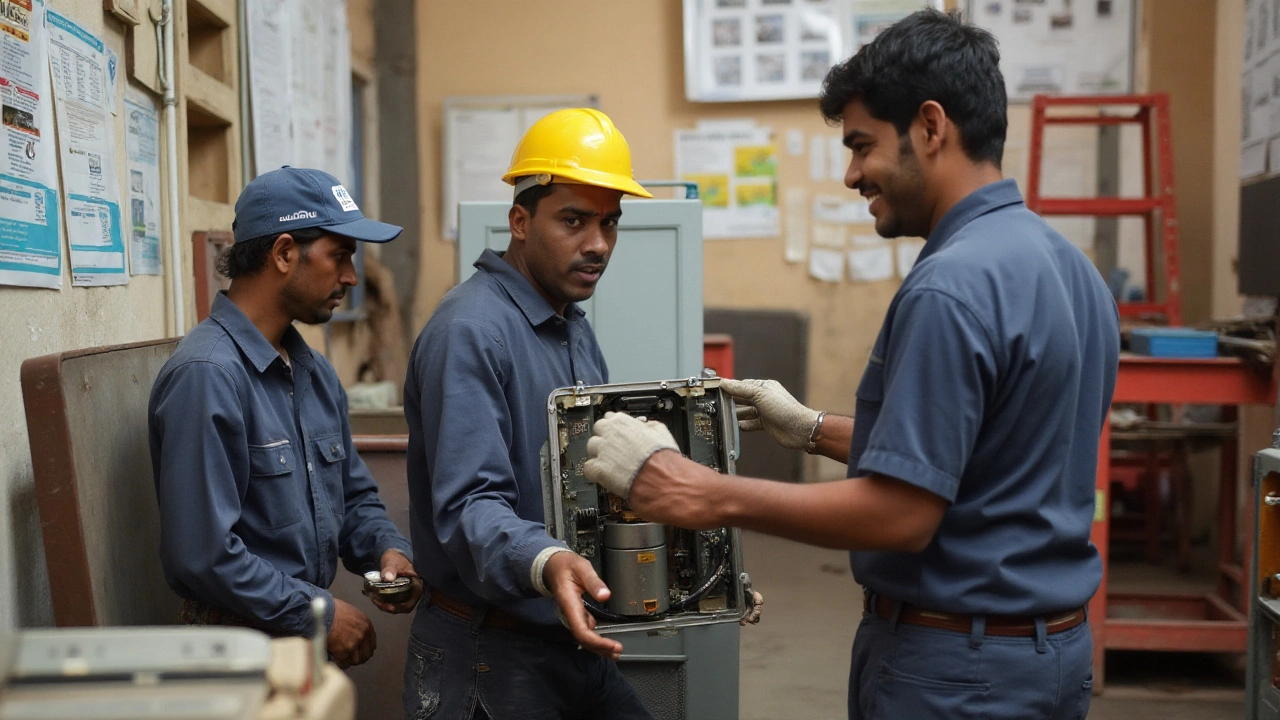
Electricians play a crucial role in keeping our homes and businesses powered and safe. While often recognized for their technical skills, the physical challenges of the job are sometimes underestimated. When you picture an electrician at work, it might seem straightforward, but what often goes unseen are the physical demands that come with it.
From lifting heavy equipment to working in awkward positions, the job can take a toll on the body. It's important for anyone considering a career as an electrician to understand these challenges and how to manage them effectively. By addressing these physical aspects early through proper training and awareness, electricians can enjoy a long and healthy career.
- Understanding the Physical Demands
- Common Tasks and Their Impact
- Safety Measures to Reduce Strain
- Importance of Fitness and Strength
- Training for Physical Endurance
- Balancing Work and Body Health
Understanding the Physical Demands
Choosing a career as an electrician involves more than just mastering the technical aspects; it requires embracing the numerous physical challenges that come with the job. Electricians frequently work in diverse environments, from residential homes with confined attics to bustling construction sites. Each location presents unique physical demands that must be navigated carefully. For instance, an electrician might spend hours standing on ladders, bending through crawl spaces, or moving heavy equipment like generators or wiring tools. These tasks require not only strength but also agility and stamina, making it imperative for electricians to be in good physical shape. On a typical day, an electrician might handle tasks that involve repetitive motion, which can lead to issues like fatigue or musculoskeletal injuries if not managed properly.
A 2023 survey conducted by the Bureau of Labor Statistics revealed that electricians have a higher incidence of workplace injuries compared to some other trades. These injuries often stem from physical exertion or improper handling of heavy materials. Notably, electric shocks or exposure to hazardous materials represent additional risks, stressing the importance of proper safety measures.
National Institute for Occupational Safety and Health (NIOSH) emphasizes the value of ergonomic practices, highlighting that 'adaptable tools and techniques can significantly reduce the risk of musculoskeletal disorders.'This underscores why proper training and awareness of bodily mechanics are so crucial in this profession.
Addressing these demands begins with understanding the typical working conditions. Electricians often find themselves in physically tight spots, requiring dexterity and flexibility. Whether crouching under a deck or twisting through a small basement entry, electricians must be prepared for anything the job throws their way. Such environments highlight the importance of maintaining body health, as the conditions can exacerbate any existing physical limitations. Engaging in regular stretching exercises can be crucial, helping to improve flexibility and reduce stress-related injuries. Also, a strong core and back are essential, as they play a significant role in lifting and maneuvering within constrained areas.
Another aspect to consider is the impact of long working hours on the body. Electricians often work extended periods, especially if projects are under tight deadlines, which increases the risk of fatigue affecting judgment and coordination. This situation emphasizes the need for breaks and adequate rest, practices that are vital for any physically demanding job, including that of electrician. It's essential for electricians to learn how to pace themselves, ensuring that they can sustain their energy levels throughout the day without succumbing to exhaustion.
Implementing regular safety assessments can also mitigate some of the physical strain electricians experience. By evaluating each job for potential hazards and planning the logistics carefully, electricians can minimize unnecessary physical hardiness. Employers can contribute by providing adequate safety gear such as knee pads and supportive footwear, which can drastically reduce the impact on joints during strenuous tasks. Making this equipment part of the daily work regimen can go a long way in promoting the wellbeing of electricians throughout their careers.
Common Tasks and Their Impact
Electricians often find themselves engaged in a variety of physically demanding tasks. Unlike many professions that confine you to a desk, working as an electrician means constant movement and adapting to different environments. These tasks can put significant strain on the body, especially over time. Imagine the daily routine: carrying heavy tools and equipment up and down ladders, crawling into tight attic spaces, or bending over to connect wires in a cramped electrical box. Such activities require not only skill but also strength, flexibility, and endurance. They contribute to issues such as back pain, joint stress, and muscle fatigue. Recognizing these physical demands is crucial not just for aspiring electricians, but also for employers looking to create a healthier work environment.
Among the most common tasks, one can find installing wiring systems in new constructions, which involves repetitive motion and standing on ladders for extended periods. This continuous repetitive motion has been known to cause wear and tear on the body, akin to the injuries seen in athletes. Electricians also frequently troubleshoot and repair electrical systems, which can involve working in awkward postures to reach electrical fixtures. These tasks often take place in challenging conditions, such as extreme temperatures or dimly-lit areas, increasing the job's complexity and physical toll.
Additionally, electricians often work independently on job sites, meaning they might not always have immediate help with physically demanding tasks. This can lead to incorrect lifting techniques that can cause strain-related injuries. According to the U.S. Bureau of Labor Statistics, electricians experience a higher rate of work-related injuries compared to the national average, a statistic that highlights the importance of health and safety protocols. These injuries can range from minor cuts and bruises to more severe incidents, emphasizing the importance of safety precautions. Engaging regularly in exercises designed to strengthen the muscles used most in these tasks can be tremendously beneficial and can significantly reduce injury risks over a career span.
"Safety is as simple as ABC – Always Be Careful. But it's more than just a saying for electricians; it’s a principle that can save lives," a seasoned electrician from the National Electrical Contractors Association once noted. Such words reflect the industry-wide recognition of physical demands faced by electricians and the ongoing need to address safety actively.
Workouts tailored to electricians, emphasizing core stability and joint mobility, have shown to greatly improve endurance and reduce the risk of strain. It’s essential for electricians to be proactive about their physical health and to seek training on safe lifting and task management. Moreover, working as part of a team can spread the workload and provide support when handling heavy or awkward materials.

Safety Measures to Reduce Strain
Working as an electrician can be tough on the body, requiring long hours, awkward postures, and handling of heavy tools. Implementing proper safety measures is crucial to minimize the physical strain. First and foremost, understanding ergonomics is essential. Ergonomics focuses on designing tasks and workspaces that fit the worker's physical capabilities, reducing the risk of strain and injury. For electricians, this means organizing their tools and equipment in a way that reduces unnecessary bending and stretching. Proper lifting techniques are another major aspect; always lift with your legs, not your back, to avoid back injuries.
Another key aspect of reducing physical strain involves using the right personal protective equipment (PPE) like gloves and non-slip footwear. PPE not only protects against electrical hazards but also helps maintain a firm grip and balance, significantly reducing stress on the body. Investing in quality knee pads is essential for those frequently working in low positions or kneeling, as they cushion the impact and distribute weight evenly. Regular breaks are also crucial, allowing muscles to relax and recover, which helps maintain stamina and prevent fatigue across longer shifts.
Stretching plays a vital role in reducing strain. It's beneficial to incorporate stretching routines before and after shifts. These routines improve flexibility, enhance blood circulation, and reduce muscle stiffness, which can help prevent injuries. A report from the National Institute for Occupational Safety and Health indicates that workers who engage in regular stretching exercises are less likely to report work-related musculoskeletal disorders. As electricians frequently work in confined spaces, stretching also increases their range of motion, making it easier to maneuver in tight spots.
"Preventative measures like stretching and ergonomic adjustments can significantly impact an electrician's longevity and day-to-day comfort," says Samuel Rogers, a renowned occupational health expert.
Tool selection is another critical factor. Tools with padded grips and those specifically designed for reduced vibration can help minimize joint and muscle strain. Cords and cables should be arranged to avoid being tripped over, and cable reels can be employed for easy storage and transportation of bulky extension cords. Having a well-organized toolbox also reduces time spent rummaging, leading to increased efficiency and less physical stress.
Regular training sessions focused on safety and ergonomic practices can be a boon for electricians. This training will update workers on new safety protocols and techniques designed to mitigate physical strain. Such training often involves demonstrations of proper lifting techniques, ways to avoid repetitive stress injuries, and the use of advanced PPE. The International Association of Electrical Inspectors advocates that ongoing safety education for electricians is crucial, as it not only enhances equipment handling skills but also instills a culture of safety among workers. Keeping safety measures at the forefront encourages electricians to take proactive steps in maintaining their health while succeeding in their demanding yet rewarding careers.
Importance of Fitness and Strength
Physical fitness and strength are crucial elements for anyone pursuing a career as an electrician. The job can be demanding, requiring individuals to perform tasks that test their endurance and physical capabilities daily. Take, for example, the necessity to lift and transport heavy materials such as cables and conduits. Electricians often find themselves in situations where they must maneuver hefty tools and equipment in confined or elevated spaces. This can place considerable stress on muscles and joints, making good physical condition a prerequisite for minimizing risk and maximizing efficiency.
Long hours standing or bending over panels and fixtures can also lead to fatigue, which can impair concentration and increase the risk of accidents. A body that is fit and strong helps in maintaining the stamina necessary to work effectively throughout the day. Not only does maintaining an optimal level of fitness support physical health, but it also enhances mental well-being, reducing stress levels that might otherwise affect decision-making on the job.
"In any profession that involves manual labor, it's imperative to engage in regular physical exercise," says Dr. Jennifer Lane, a renowned occupational therapist. "Not only does it improve endurance, but it also makes a significant difference in injury prevention."
Another aspect to consider is the preventive power of good fitness habits. Regular exercise that targets muscle strength, cardiovascular health, and flexibility can mitigate common physical ailments associated with the profession, like back pain and repetitive strain injuries. Building a fitness routine that includes a mix of aerobic exercises and weight training sessions can prepare an electrician for the day-to-day challenges they will face on the job, providing a foundation of strength and resilience.
Workplaces are increasingly acknowledging the importance of supporting the physical health of their employees. Some companies provide gym memberships or encourage participation in fitness challenges, recognizing that physically healthy workers are often more productive and have better attendance records. Aspiring electricians should take advantage of these opportunities, seeking personal wellness programs that can guide them in maintaining their health over the span of their careers. By focusing on fitness and strength from the outset, electricians can enjoy a fulfilling and sustainable career while prioritizing their longevity and overall well-being.

Training for Physical Endurance
Stepping into the shoes of an electrician, one might initially focus on mastering the technical know-how, yet it becomes apparent that training for physical endurance is equally crucial. An electrician's day is varied: awkwardly positioned beneath crawl spaces, stretching high atop ladders, or navigating crowded job sites often filled with large obstacles. Handling these tasks efficiently requires not just skill, but a body conditioned to withstand strenuous activity. Thus, incorporating fitness routines geared towards improving stamina and strength becomes indispensable.
Regular physical activity is vital to build the endurance needed for an electrician's job. This doesn't mean preparing for a marathon, but engaging in exercises that mirror the physical demands found in their daily routine. Cardiovascular exercises, like brisk walking or cycling, improve heart health and boost stamina, enabling workers to manage long hours of labor without undue fatigue. Additionally, strength training focusing on core, shoulders, and legs can offer immense benefits. Lifting, squatting, and balancing are integral parts of an electrician's tasks, demanding muscles strong enough to endure over time. A well-planned fitness routine can significantly enhance one's ability to handle the job's physical elements.
"Strength doesn't come from what you can do, it comes from overcoming the things you once thought you couldn't," shares a seasoned electrician, emphasizing the importance of building both physical and mental resilience.
Proactive efforts in training can not only foster physical health but potentially prolong an electrician's career. Incorporating flexibility exercises like yoga or dynamic stretching aids in reducing risks of strain injuries, often seen in the industry. This can be especially helpful when electricians spend extended periods in fixed or awkward postures. These routines enhance muscle flexibility, enabling electricians to maneuver efficiently in confined spaces. Similarly, specific exercises that improve joint strength can help prevent common ailments, such as back and knee pains.
Structured training programs aren't merely suggestions—they are precautions. In the broader construction sector, data suggests injury rates are notably high among workers not conditioned for physical demands. To combat this, many trade schools emphasize endurance training alongside technical education, echoing its necessity. A blend of the two instills a well-rounded approach to the trade, equipping future electricians with knowledge, skill, and solid physical health—a comprehensive package essential in sustaining a successful career in the electrical field. This integrated approach ensures that while knowledge can solve problems, a physically sound body can ensure tasks are executed safely and efficiently.
Balancing Work and Body Health
Maintaining a balance between work as an electrician and ensuring your body remains in good shape is not only advisable but necessary. Daily tasks can push physical limits, but by understanding these demands, one can take steps to mitigate long-term impacts. Electrical work often involves repetitive motion, awkward positions, and carrying heavy loads. All these factors combined may lead to muscle strain or injuries over time. Recognizing warning signs early and implementing proactive strategies can help preserve both physical health and career longevity.
Electricians should pay close attention to ergonomic techniques. Lifting with the legs rather than the back, maintaining a straight posture even when reaching for wires, and taking regular breaks can drastically reduce the wear on muscles and joints. Stretching before starting a highly physical task loosens up the body, allowing flexibility and reducing injury risk. Regular exercise outside of work such as yoga or strength training specifically targets and strengthens vulnerable muscle groups, providing greater resilience. Adopting such practices will ensure that the physical demands of the job don't translate into undue stress on the body.
Besides physical fitness, considering proper nutrition is equally significant. A balanced diet can reinforce muscle health and improve energy levels, which is vital when engaging in such labor-intensive activities. Electricians should stay hydrated, as dehydration can adversely affect both cognitive and physical performance. Engaging in activities that relieve stress, such as meditation or spending time with family, contribute positively to both mental and physical health. A steady commitment to these holistic approaches ensures electricians maintain a sound body and alert mind.
"By taking simple steps in their daily routine, electricians can significantly improve their working conditions and health outcomes." - Dr. J. Goldberg, Occupational Health Expert.
Technology and personal protective gear play critical roles in reducing physical strain. Utilizing specialized tools that enhance ergonomic handling can ease the burden of repetitive tasks. Battery-operated drills, for example, lessen the need for force when managing frequent installations. Adequate safety equipment such as robust gloves and supportive footwear help cushion impacts and reduce fatigue. Investment in quality tools and attire is a proactive step toward sustaining body health in this demanding field.
Moreover, the workplace environment should encourage an ongoing dialogue about safety and body health. Electricians working in teams can benefit from collective insights about newer, safer, and more efficient working methods. Periodical training and workshops emphasize not only safety precautions but also alert electricians to new research findings or advancements in technology that might minimize physical strain. Companies that foster this culture of awareness see lower injury rates and enjoy a more satisfied workforce.
Electrician training programs should also include modules that educate about body health as an intrinsic part of their curriculum. As prospective electricians are introduced to the technical facets, integrating physical health management principles assures a more comprehensive training experience. Such educational initiatives equip them with the knowledge to adapt their techniques early on, allowing them to work more smartly and safely.
